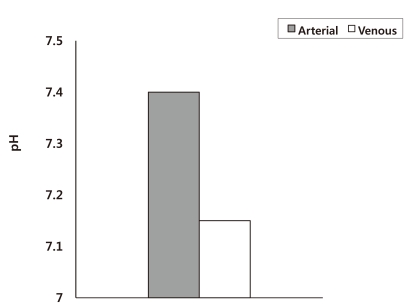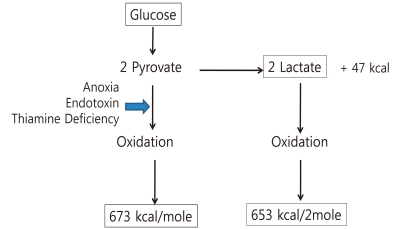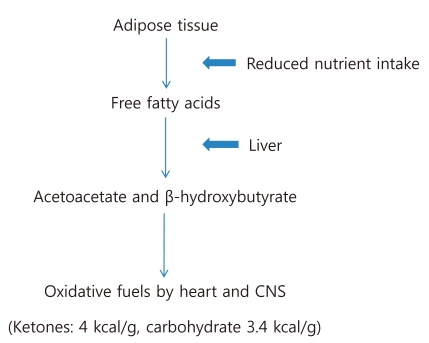Electrolyte Blood Press.
2010 Dec;8(2):66-71.
Acid-Base Disorders in ICU Patients
- Affiliations
-
- 1Department of Internal Medicine, Seoul National University Boramae Medical Center, Seoul National University College of Medicine, Seoul, Korea. yoonkyu@snu.ac.kr
Abstract
- Metabolic acid-base disorders are comnom clinical problems in ICU patients. Arterial blood gas analysis and anion gap (AG) are important laboratory data in approaching acid-base interpretation. When measuring the AG, several factors such as albumin have influence on unmeasured anions and unmeasured cations. If a patient has hypoalbuminemia, the AG should be adjusted according to the albumin level. High AG metabolic acidoses including lactic acidosis, ketoacidosis, and ingestion of toxic alcohols are common in ICU patients. The treatment target of lactic acidosis and ketoacidosis is not the acidosis, but the underlying condition causing acidosis. Gastric acid loss, diuretics, volume depletion, renal compensation for respiratory acidosis, hypokalemia, and mineralocorticoid excess are common causes of metaboic alkalosis. In chloride responsive metaboic alkalosis, volume and potassium repletion are mandatory.
MeSH Terms
Figure
Reference
-
1. Gauthier PM, Szerlip HM. Metabolic acidosis in the intensive care unit. Crit Care Clin. 2002; 18:289–308. PMID: 12053835.
Article2. Winter SD, Pearson JR, Gabow PA, Schultz AL, Lepoff RB. The fall of the serum anion gap. Arch Intern Med. 1990; 150:311–313. PMID: 2302006.
Article3. Figge J, Jabor A, Kazda A, Fencl V. Anion gap and hypoalbuminemia. Crit Care Med. 1998; 26:1807–1810. PMID: 9824071.
Article4. Casaletto JJ. Differential diagnosis of metabolic acidosis. Emerg Med Clin North Am. 2005; 23:771–787. PMID: 15982545.
Article5. Weil MH, Rackow EC, Trevino R, Grundler W, Falk JL, Griffel MI. Difference in acid-base state between venous and arterial blood during cardiopulmonary resuscitation. N Engl J Med. 1986; 315:153–156. PMID: 3088448.
Article6. Brooks GA. Lactate production under fully aerobic conditions: the lactate shuttle during rest and exercise. Fed Proc. 1986; 45:2924–2929. PMID: 3536591.7. Mizock BA, Falk JL. Lactic acidosis in critical illness. Crit Care Med. 1992; 20:80–93. PMID: 1309494.
Article8. Forsythe SM, Schmidt GA. Sodium bicarbonate for the treatment of lactic acidosis. Chest. 2000; 117:260–267. PMID: 10631227.
Article10. Charfen MA, Fernandez-Frackelton M. Diabetic ketoacidosis. Emerg Med Clin North Am. 2005; 23:609–628. PMID: 15982537.
Article11. Wrenn KD, Slovis CM, Minion GE, Rutkowski R. The syndrome of alcoholic ketoacidosis. Am J Med. 1991; 91:119–128. PMID: 1867237.
Article12. Gabow PA, Clay K, Sullivan JB, Lepoff R. Organic acids in ethylene glycol intoxication. Ann Intern Med. 1986; 105:16–20. PMID: 3717806.
Article13. Caravati EM, Erdman AR, Christianson G, et al. Ethylene glycol exposure: an evidence-based consensus guideline for out-of-hospital management. Clin Toxicol (Phila). 2005; 43:327–345. PMID: 16235508.
Article14. Oh MS. Unconventional views on certain aspects of toxin-induced metabolic acidosis. Electrolyte Blood Press. 2010; 8:32–37.15. Barceloux DG, Bond GR, Krenzelok EP, Cooper H, Vale JA. American Academy of Clinical Toxicology practice guidelines on the treatment of methanol poisoning. J Toxicol Clin Toxicol. 2002; 40:415–446. PMID: 12216995.16. Wilson KC, Reardon C, Theodore AC, Farber HW. Propylene glycol toxicity: a severe iatrogenic illness in ICU patients receiving IV benzodiazepines: a case series and prospective, observational pilot study. Chest. 2005; 128:1674–1681. PMID: 16162774.18. Brimioulle S, Vincent JL, Dufaye P, Berre J, Degaute JP, Kahn RJ. Hydrochloric acid infusion for treatment of metabolic alkalosis: effects on acid-base balance and oxygenation. Crit Care Med. 1985; 13:738–742. PMID: 3928258.19. Marik PE, Kussman BD, Lipman J, Kraus P. Acetazolamide in the treatment of metabolic alkalosis in critically ill patients. Heart Lung. 1991; 20:455–459. PMID: 1894525.
- Full Text Links
- Actions
-
Cited
- CITED
-
- Close
- Share
- Similar articles
-
- Acid-base Disorders in Status Epilepticus
- Clinical Significance of Strong Ion Gap: between ICU and Hemodialysis Patients with Metabolic Acidosis
- A Study of the Need of Clinical Expert System for Acid-Base Diagnosis
- Metabolic Disorders of Acid Base Balance
- A comparison of traditional and quantitative analysis of acid-base and electrolyte imbalance in 87 cats




